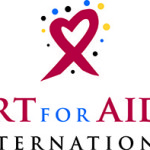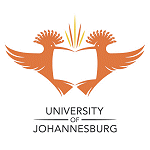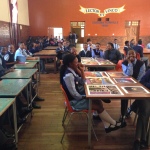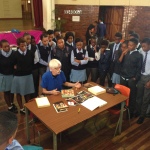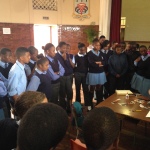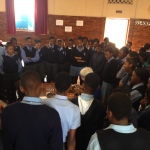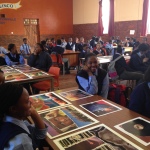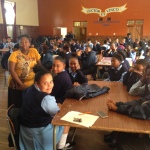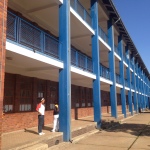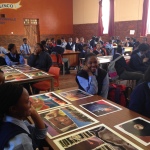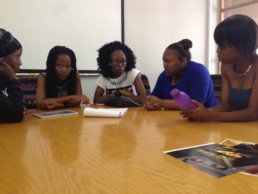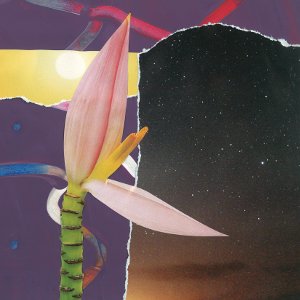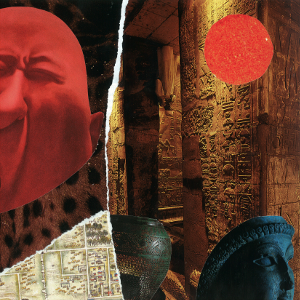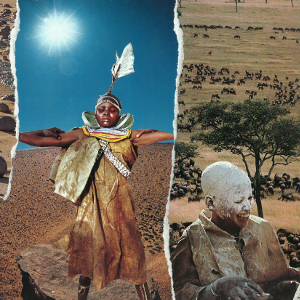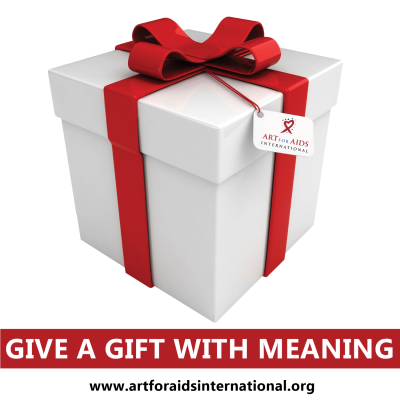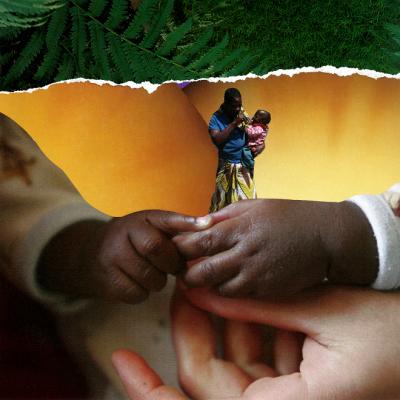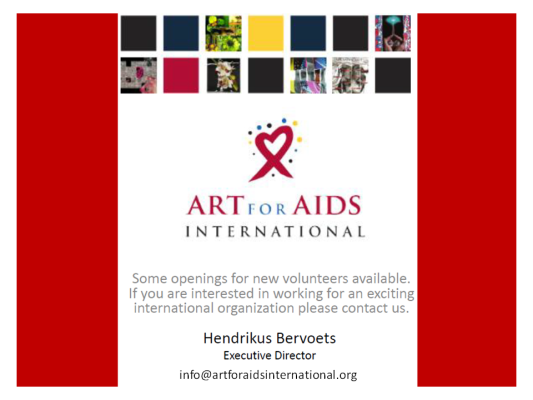92 Students at today's workshop!
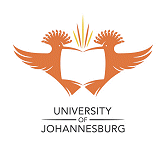
 Today we had 92 students at our Coronation S.S. Art for AIDS International- U.J. Workshop.
Today we had 92 students at our Coronation S.S. Art for AIDS International- U.J. Workshop.
In the end we had 72 students creating artwork. Many thanks to all the students and Community Engagement.
Continuing Train the Trainer Program in Africa
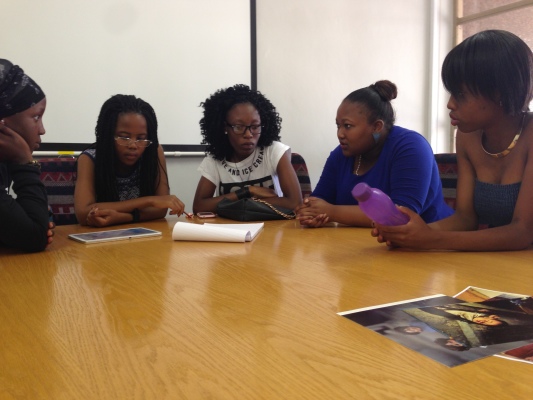
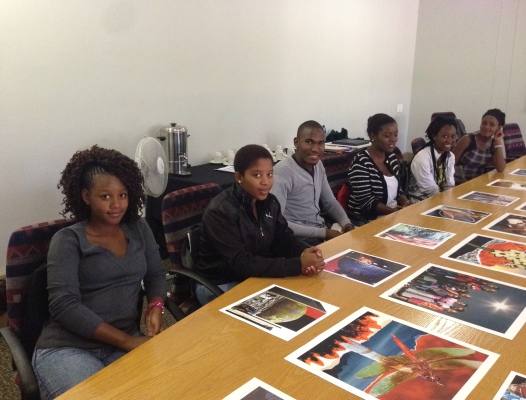
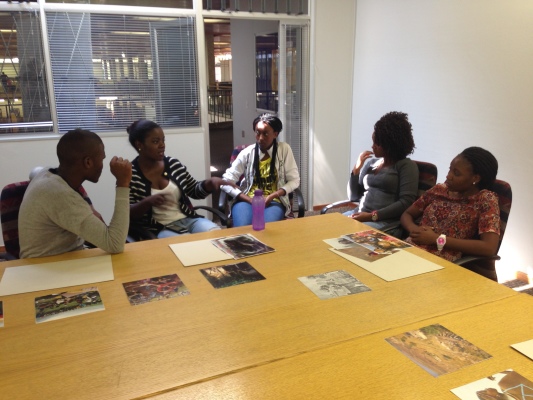 Art for AIDS International is working all this week once again with new facilitators, who are preparing their own personal stories for use in conducting their own workshops with younger peers. It is very encouraging to see the serious faces in the photos from Africa which show how passionate these young blossoming leaders are about making positive change in the world.
Art for AIDS International is working all this week once again with new facilitators, who are preparing their own personal stories for use in conducting their own workshops with younger peers. It is very encouraging to see the serious faces in the photos from Africa which show how passionate these young blossoming leaders are about making positive change in the world.
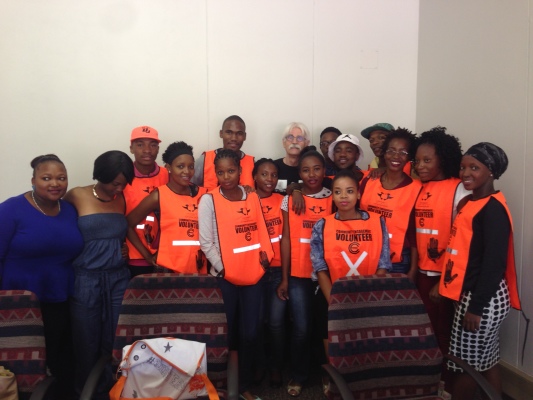
Train the Trainer in Africa
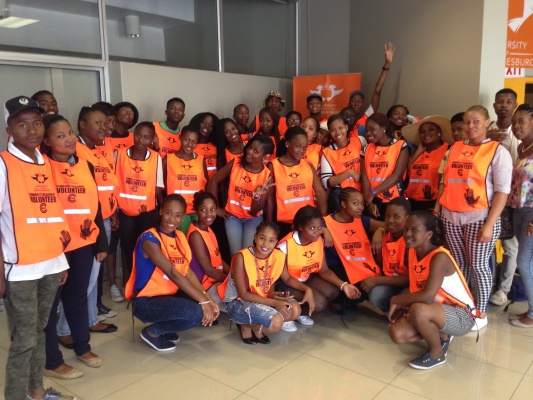 The Train the Trainer program is well under way in South Africa since Art for AIDS International's facilitator arrived last week. It is wonderful to see the smiling faces of young people in training to lead workshops, as well as the beautiful pieces of artwork coming out of the collage-making portion of their time together. Student evaluation surveys have been very positive with high scores for participant satisfaction. We are very grateful to the University of Johannesburg's Department of Community Engagement for organizing these workshops and helping to make it all possible.
The Train the Trainer program is well under way in South Africa since Art for AIDS International's facilitator arrived last week. It is wonderful to see the smiling faces of young people in training to lead workshops, as well as the beautiful pieces of artwork coming out of the collage-making portion of their time together. Student evaluation surveys have been very positive with high scores for participant satisfaction. We are very grateful to the University of Johannesburg's Department of Community Engagement for organizing these workshops and helping to make it all possible. 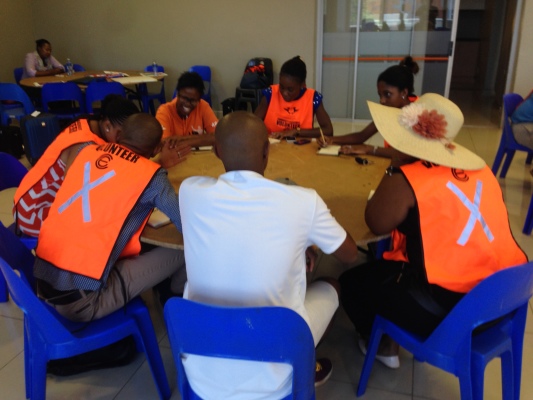
Self Esteem, Art, and the Fight Against HIV and AIDS
This post was written by Brittany Stares, Volunteer for Art for AIDS International
Building self-esteem was not always part of what Art for AIDS International does, Director Hendrikus Bervoets tells me one afternoon. It came up a few years ago when he was asked to give a keynote address in Botswana on the topic of bullying. At first, he says, he didn't know what to talk about. Then, the more he thought about it, the more connections appeared between self-esteem and his work with Art for AIDS International.
Now, building self-esteem is a cornerstone of what the organization does. He explains to me the many links between self-esteem and the HIV and AIDS fight: individuals need strong self-esteem to get tested, learn their status, and pursue treatment in the face of widespread discrimination. Low self-esteem can contribute to the risky behaviours that spread HIV, such as IV drug use and unprotected sex. Building self-esteem, while perhaps not enough to end AIDS-related bullying based on psychologists' new understanding of bullies, is still pivotal in creating healthy interpersonal relationships, healing the damaging legacy of bullying for victims, and challenging the HIV and AIDS stigma. The need for strong self-esteem even reaches educators if they are to share their experiences about self-worth, gender violence, and health with students – and building the capacity of educators is part of Art for AIDS International's “Train the Trainer” program.
For young people, building positive self-esteem starts lifelong change. Art, Hendrikus says, is a great way to do this because it's fun. “Because of what we ask students to do [to select images at random and not overthink], it makes it very easy to create beautiful artwork,” he explains. I can speak to that. Artistically challenged enough that even a straight line with a ruler seems hard, I have participated in an Art for AIDS International workshop and created collages that now hang on my wall with pride. For workshop participants, they create not only beautiful art, but art that is taken seriously and treated with respect – gorgeously displayed in showings around the world and sold on the Art for AIDS International website.
Hendrikus now starts every workshop with a talk, one that includes not only important, potentially lifesaving information about HIV and AIDS, but also his own experiences with low self-esteem. “It helps young people to become aware of the difference between low self-esteem and healthy self-respect,” he says, “[It brings an] awareness that they're not the only ones with low self-esteem... many young people have it, but we seldom talk about that.”
At these workshops, Hendrikus says young people change in front of his eyes. “You find them becoming passionate and excited about what they're doing,” he tells me. “That is really pretty universal, whether the workshop is in Canada or South Africa. Wherever we go, we see the same response.”
In the fight against AIDS, the role of self-esteem is often overlooked. This is where organizations like Art for AIDS International make such a difference: they deliver crucial information about HIV and AIDS to the community, but they also strengthen the foundations that will help individuals use this information for themselves and others. I know from reading workshop reviews by participants in Botswana and South Africa that the seeds planted in these sessions will go well beyond the HIV and AIDS fight: they will inspire community service, connect family members, and help individuals pursue their dreams. Self-esteem is what puts the roots in grassroots change.
A Return to Hopefulness
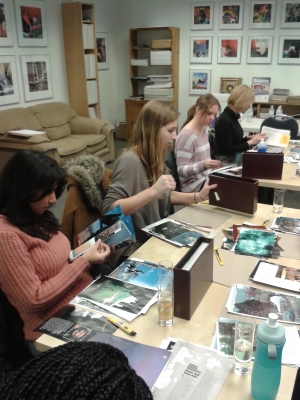
This post was written by Sarah Barzak, volunteer for Art for AIDS International in London, Canada
Social justice has been and continues to be a concept I keep in the back of my mind. Immigrating to Canada at the age of five, social issues were heavily discussed at the dinner table and watching the 10pm news was a daily activity in our household. All throughout high school I participated in social justice, multi-cultural and volunteer service clubs. Participating in those activities allowed me to bond with like-minded people and also kept me engaged with current issues. More importantly, it made me realize that there’s always a position to play in the grand scheme of things. However, once in university, studying the complexities of social issues made me reassess my views. I started to label my thinking as ‘idealistic’ and became skeptical of how my actions could contribute in solving social problems. Injustice seemed to be everywhere: locally and globally; and seemed too big to tackle. Now, instead of feeling hopeful, I felt angry. I was angry because I was under the impression that not enough people cared, not enough people were informed and too many were ignorant. The culture of the university lecture played a big part in cultivating my skepticism. The constant critiquing and analyzing of theories was brought out of the classroom and into my day-to-day life to which those feelings felt inescapable. After some time, I thought to myself I wasn't happy with my current attitude and I missed feeling hopeful. I missed encountering an issue and thinking: “hey, what can I do to be a part of the solution” instead of ‘conceptualizing the complexities’ as I would in class.
Volunteering for Art for AIDS International was a step I took in trying to bring back that hope. When I came into the volunteer workshop, it was my first time interacting with the other volunteers and I was moved by the honesty and openness of the environment. I felt overjoyed because it was my first time since graduating high school that I felt that level of warmth and comfort in my surrounding. What fascinated me the most about the organization was its way of having art work as a vessel to carry out discussion. I especially admired the organization’s role in working with young people in hopes to evoke consciousness of both social and personal matters. Making collages brought out a different mode of thinking in which I didn’t have to rationalize, I could as Hendrikus put it: “play”. I think part of working with art is allowing your mind to think freely in order to showcase alternative perspectives and modes of expression. Something about not thinking critically felt therapeutic and initiated a feeling of ‘at-one’ with myself. This was an important step in my self-reflection process because it served as an opportunity to regenerate. Also, listening to Hendrikus’ story made me realize that my experience is indeed a part of a journey. Though I may experience ups and downs, disappointments and accomplishments, it is important to always be honest with myself. All in all, I’m excited to work with Art for AI International, not only to see how a charitable organization operates but also to add to my life long learning experiences. 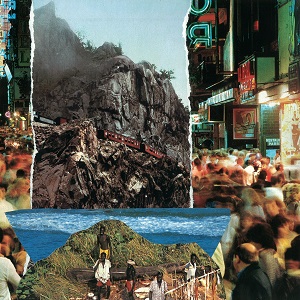
Unlocking Emotions Through Art
This blog was written by Brittany Stares, volunteer
I volunteer in the Art for AIDS International gallery, a place that, despite the beautiful artwork on the walls, doesn't always convey the depth of the organization’s work. My first experience with Art for AIDS International was reviewing evaluations of the workshop from Botswana and South Africa to draw out useful content for social media. It was a startlingly moving experience. Students were not describing the workshop as merely “fun” or “educational,” they described it – over and over again – as life changing. An immeasurable source of confidence. A first step into helping their family and community.
Last month, Hendrikus Bervoets, Executive Director for Art for AIDS International, hosted one of these workshops for volunteers. Art is an area I enjoy the way a child enjoys splashing in the pool: with sheer delight, even though I’m terrible at it. As expected, the workshop taught me a lot about HIV and AIDS (enough that I promptly shared stats about the disease via Facebook right after), as well as the background of the organization. But it also taught me something about myself, and the power of art.
During the workshop, torn paper became art at my fingertips. I felt a fierce attachment to the work I was creating. More, I felt a sense of pride; it was the first thing in weeks I’d felt pride in. I felt disappointment when my collage was taken away, even to become a print. That night, I couldn't sleep. I tossed and turned and felt a storm of emotions unrelated to the workshop – anger, hurt, unhappiness, frustration. I knew enough about feelings to recognize that this wasn't bad. Art, like play therapy, can allow us to access feelings and emotions we may not be immediately aware of. It can allow us to tap into anything from built-up stress and tension from the day to day to major grief and pain from past trauma. This might be unpleasant to feel, but it’s important – without feeling it, we cannot heal it. Our feelings deserve “the dignity of our attention,” and there is is nothing worse, or more damaging in the long run, than blocking off what we feel.
My feelings that night were large and difficult. They were rooted in questions about where my life was going, if I was making the right choices. These are feelings that, at this point in my life, will be around for a while, and healing will be an ongoing process. But today, as I saw my collage as a finished print, I felt peace.
“Inspiring Confidence & Compassion one Collage at a Time”
Give a Gift with Meaning
With holidays and gift-giving occasions fast approaching, please keep in mind that a beautiful piece of art work from our collection is a wonderful way to remember special people in your life. Not only would they receive a lovely print, but they would know that the money spent supports our work as we raise awareness and give young people a voice in their response to the HIV and AIDS pandemic, as well as other social justice issues affecting the world around us.
Volunteering at Art for AIDS International
As Father's Day weekend approaches, we at Art for AIDS International count our blessings for the presence of loving and supportive fathers and the role that they play in our North American society. In Africa, it is not always the case. We are working hard to make a difference in the lives of children orphaned through HIV/AIDS. If you are interested in helping us in our efforts, we can be contacted through our website or also through our new profile at www.getvolunteering.ca.
Volunteer Positions Available
We are excited about some upcoming events that will be happening locally. There is also a plan to visit Africa again in the near future. With this in mind, Art for AIDS International is open to new volunteers joining our efforts in order to make it a very effective and exciting summer! Please do contact us if you or someone you know would like to work with us and help make a difference. We are interested in local volunteers to work in London, Ontario at this time. Thank you for your continued support.
